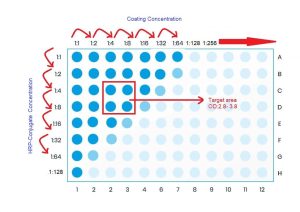No products in the cart.
ELISA Set up by ELISA Checker-board & Importance of Checker-board procedure for ELISA optimization:
Checker-board procedure for ELISA Kits is an ELISA technique that is essential step in immunoassay kits set-up. That is an ELISA optimization for antigen or Antibody against sample concentration that is crucial for Indirect ELISA protocol, Sandwich ELISA development and Homemade ELISA kits.
ELISA development and validation procedure strongly depends on ELISA Coating concentration and ELISA conjugate concentration against target analyte. ELISA Checker-board is an adjusting method of Immunoassay products in normal range but will give obvious predictable results for low and high analyte concentration in ELISA kit action.
Optimization of ELISA kits by Checker-board prevent test from adverse reactions such as gaining high ELISA signal, low ELISA signals and will provide acceptable and normal range of analyte detection by avoiding from Hook effect. We recommend using Standard ELISA Reagents for your set-up.
Also, ELISA parameters such as linearity, Recovery, Precision, Within-run precision, and Between-run precision and etc, are totally related to ELISA set-up by checker-board.
How to optimize ELISA Parameters by Checker-board?
Checker-board is a serial dilution of Antibody or Antigen in ELISA coating Buffer against Conjugated antibody in HEP-Conjugated Buffer considering the normal range of analyte that ELISA goes to run for. Normally you should do fallowing steps:
- Determine the concentration of analyte for test. The best concentration for Direct ELISA and Indirect ELISA is different, but for example if your range is from 0 ng/ml to 100 ng/ml, it is suggested to use analyte concentration about 65 to 75 ng/ml as your sample concentration.
- Determine first Row s (8 wells) coating concentration. It is suggested to use 2-5 times more concentration of a normal ELISA coating. (5-7 microgram/ml)
- Determine first Rows (12 wells) Conjugated antibody concentration. It is recommended to use 0.5 to 1.5 microgram/ml of Conjugate in conjugated buffer.
Then you should perform as below:
1) ELISA Checker-board Coating
*Dispense 100 µL of ELISA coating buffer in all wells of ELISA plate.
*Dispense 100 µL of your coating Ag or Ab (Pre-diluted in Coating buffer with certain and determined concentration 5 microgram/ml in picture) in plate first row. (8 wells)
*Do Serial Dilution in entire ELISA Plate and discard final 100 µL.
*Cover the plate with ELISA Plate covers to prevent drying and put plate at refrigerator for 18 to 24 hours.
2)Blocking of ELISA Plates
- Bring the coated plate to RT and let stay 30 Min.
- Wash the plate with PBS, PH= 7.4, 5times.
- Add 100 µL of ELISA Plate Blocking solution and shake for 5 Min.
- Discard Blocker and place the plate upwards to dry. (10-12 hours at RT or 1 hours at 10C vacuum chamber)
Seal ELISA plates and keep them refrigerated.
3)Performing a Normal ELISA Test
^^^^ You need to determine your specimen and reagent volumes but normally in ELISA test sample is from 5-50 µL and Conjugate is from 50-200 µL.
- Add 200 µL of your highest concentration of your HRP-Conjugate (3-5 microgram/ml) in proper HRP-Conjugated Buffer to 1st column.
- Add 100 µL of conjugated buffer to all other columns. (Remember that in Coating step you diluted your coating against rows.)
- Do serial dilution of HRP-Conjugate against columns and discard final 100 µL out.
- Add 50 µL sample to all your wells.
- Cover the plate and incubate for 45min-2 horse in RT or 37C.
- Wash the wells 3-5X.
- Add ELISA TMB-Substrate to all wells.
- Incubate 10-20min at dark.
- Add 100 µL ELISA Stop solution.
- Read the test in 10 min.
Note: Using optimized ELISA Coating Buffer, ELISA Bloking Buffer, HRP-Conjugate Stabilizer, Sample diluent and ELISA TMB Solution will finally save your time and budget to set-up your ELISA test & kit.
ELISA Checker-Board Results will be something like this:




